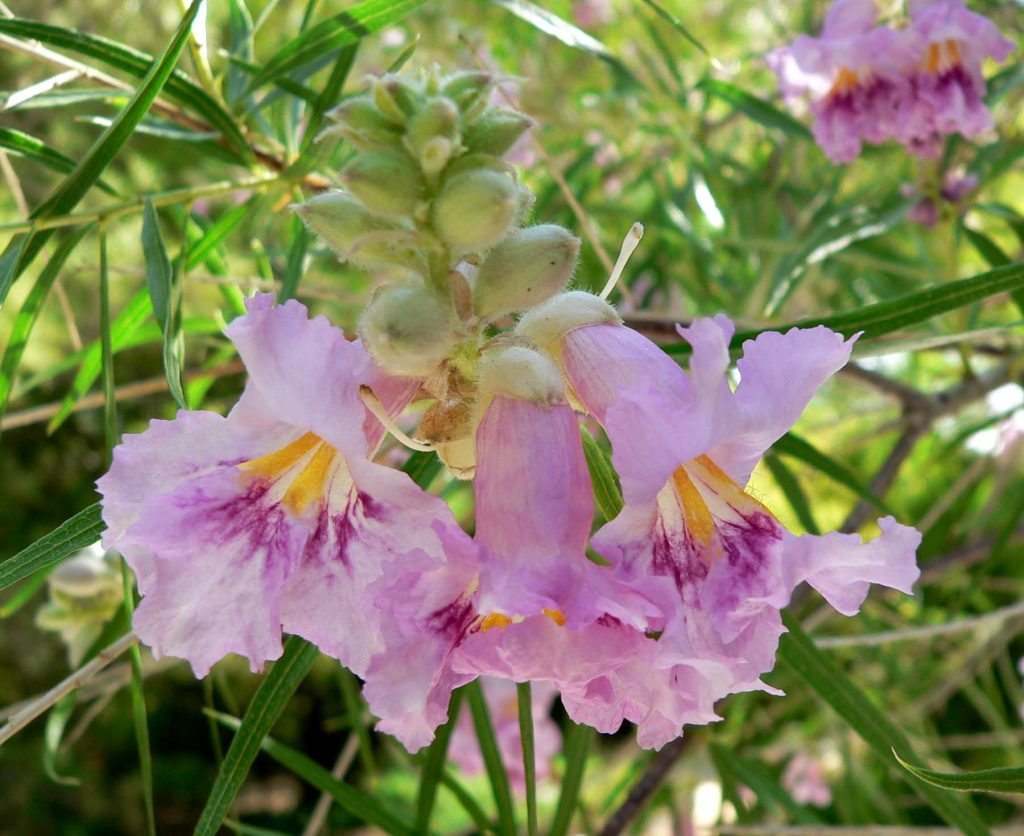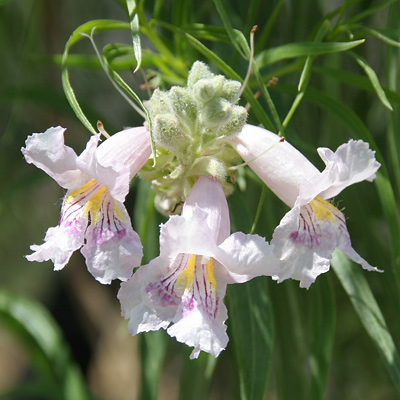Chilopsis linearis

Chilopsis linearis, commonly known as Desert Willow, is a captivating flowering tree native to the southwestern United States and northern Mexico.
Renowned for its graceful form, delicate blooms, and tolerance to arid conditions, this species holds both ecological and cultural significance in desert ecosystems.
In this comprehensive article, we will delve into the botanical intricacies, habitat preferences, life cycle, ecological importance, conservation status, and care guidelines for Chilopsis linearis.
Botanical Description
Desert Willow is characterized by its slender, arching branches, narrow leaves, and trumpet-shaped flowers.
The tree typically grows to a height of 15 to 30 feet (4.5 to 9 meters) with a spread of 10 to 20 feet (3 to 6 meters).
The leaves are linear or lance-shaped, arranged alternately along the branches, and may have a gray-green or bluish-green coloration. In late spring to early summer, Desert Willow produces an abundance of fragrant flowers that range in color from white to pink to lavender.
The flowers attract pollinators such as bees, butterflies, and hummingbirds and give way to long, slender seed pods that persist into fall.
Habitat and Distribution
Desert Willow is native to a variety of habitats, including desert washes, riparian areas, and arroyos, throughout the southwestern United States and northern Mexico.
Desert Willow excels in arid climates, flourishing near streambanks, riverbeds, and water sources.
Its deep roots access water in dry soil, enabling resilience. Additionally, it tolerates various well-drained soil types.
Life Cycle and Phenology
As a perennial tree species, Chilopsis linearis undergoes a yearly life cycle marked by seasonal growth and flowering.
New growth emerges in spring, with the tree producing an abundance of flowers that cover the canopy in a profusion of color.
Flowering typically occurs in response to rainfall or periods of increased moisture, signaling the onset of the growing season.
The flowers are pollinated by bees and other insects, with seed production and dispersal occurring in summer.
Desert Willow may experience a period of reduced growth and dormancy in winter, but it remains green and photosynthetically active throughout the year.
Ecological and Cultural Importance
Desert Willow plays a vital ecological role as a habitat provider, supporting a diverse array of wildlife species.
The flowers attract pollinators such as bees, butterflies, and hummingbirds, contributing to the health and diversity of local ecosystems.
The seeds are eaten by birds and small mammals, while the foliage provides shade and refuge for desert wildlife.
Additionally, Desert Willow has cultural significance as a symbol of resilience, adaptability, and beauty in arid landscapes.
It is often used in landscaping and revegetation projects to restore degraded habitats and stabilize soils.
 Caring for Chilopsis linearis
Caring for Chilopsis linearis
Sunlight
Plant Desert Willow in a location that receives full sun, as it requires abundant sunlight to thrive and bloom profusely.
Watering
Provide regular water during the establishment period, but once established, Desert Willow is highly drought-tolerant and requires minimal supplemental irrigation.
Allow the soil to dry out between waterings to prevent root rot.
Soil
Plant in well-drained, sandy or rocky soil with a neutral to slightly acidic pH.
Desert Willow is tolerant of a wide range of soil types but prefers good drainage.
Mulching
Apply a layer of organic mulch around the base of the tree to conserve moisture, and regulate soil temperature. Keep the mulch several inches away from the trunk to prevent rot.
Pruning
Prune Desert Willow as needed to remove dead, diseased, or damaged branches.
Additionally, thin out crowded growth to improve air circulation and overall tree health.
Follow these care guidelines to nurture thriving Chilopsis linearis trees, enhancing arid environments and celebrating desert-adapted species' resilience and adaptability.
Desert Willow captivates in xeriscape gardens, desert oases, and wildlife-friendly landscapes.
Leave a Reply
You must be logged in to post a comment.